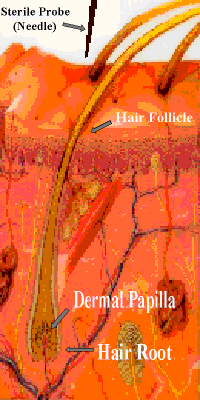Electrolysis

Electrolysis, a technique used for the destruction of unwanted hair follicles, has been in use since 1875. The treatment is delivered through a single, sterile probe / needle that is gently inserted into the hair follicle. You will not feel the insertion. When the probe reaches the end of the follicle where the hair root meets the dermal papilla (blood source to the hair follicle), a small amount of heat is emitted (which feels like a tingle). This heat dehydrates the bulb and basically cauterizes the junction between the hair root and the papilla; without a blood source the follice dies.
The U.S. Food and Drug Administration (FDA) recognizes electrology as providing permanent hair removal. The FDA identification in Title 21, CFR, Sec. 878.5350 for needle-type epilators is: “ a device intended to remove the hair by destroying the dermal papilla of a hair”. As no other device for hair removal has the unique identification of “destroying the dermal papilla of a hair”, only electrologists are allowed to claim permanent hair removal in their advertising. No other hair removal devices, including lasers, have been able to achieve this definition.
Electrolysis is the only method proven to remove hair permanently. The number of treatments varies with each person depending on their hormone levels. It is very important to adhere to the recommended treatment schedule to achieve optimum results in the shortest period of time. While electrolysis is not totally comfortable, it is impossible to destroy hair growth tissue without any sensation. Most people find the brief sensation of heat to be quite tolerable.
Hirsutism, or the growth of excess of androgens (ie: testosterone) vary throughout your life but are more prevalent during puberty, pregnancy and menopause. Medications, obesity and illness may also cause hirsutism and may require physician intervention. Electrolysis is necessary to premanently remove a hair that has been activated; it will not go away on its own.
Electrolysis is very safe, especially when performed by an electrologist who is board certified. It is important to find an electrologist with C.P.E. (Certified Professional Electrologsit) behind their name. This means that they have passed a national exam and keep up with the required continuing education to maintain the C.P.E. status. Additionally, strict adherence to the "Infection Control Standards" set forth by the American Electrology Association is practiced in this office. Close attention is also given to other infection control measures including hand washing, gloves, sterile / disposable probes and sterilization of instruments, to name a few.
Accreditations



